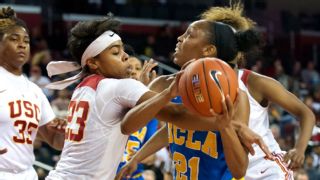|
No conference has improved its quality depth and used strong scheduling to raise its RPI as much as the Pac-12 has in recent years. This seems to be paying off. Three Pac-12 teams were included in the NCAA women's basketball selection committee's first release of its top 10 teams Monday. Conference leader Arizona State, which was No. 7 on the list, and Oregon State (No. 8) were not surprises. But UCLA, which is 16-5 overall and 8-2 in the Pac-12, was. The Bruins, who came in at No. 17 overall in the latest bracketology projections and were No. 14 in Monday's AP Top 25 poll, were ranked No. 10 on the NCAA's list. NCAA Selection Committee chairwoman Chris Dawson said UCLA was selected just ahead of (in alphabetical order) Florida State, Louisville, Mississippi State and Texas A&M. Those other four schools have been consistently ahead of the Bruins in both bracketology and top-25 rankings over the past month. "We probably spent over an hour of our conference call discussing the bottom half. For example, the discussion around UCLA centered around strength of schedule and RPI, with no bad losses and playing well in losses," Dawson said Monday during a phone interview. "A lot of our discussion was around all the teams' strength of schedule and the ability to win and be competitive in those games."  Undefeated UConn leads the NCAA's list, followed by South Carolina, Notre Dame, Baylor and Texas. Ohio State is No. 6, and Maryland was ninth. Clearly, UCLA's close losses to both South Carolina (68-65 on Nov. 22) and Notre Dame (92-84 in overtime on Nov. 28) and the boost those games gave the Bruins' strength of schedule (SOS) had a big impact on the committee. UCLA's résumé really isn't better than that of, say, Louisville or Texas A&M. For comparison, the Cardinals have more top-50 wins (five vs. four). UCLA's best nonconference win was over St. John's; the Cardinals' top nonleague win was over Michigan State. The Bruins do far better in the losses category. Their worst loss is to Cal. Louisville also lost to Cal but fell to Western Kentucky, another team outside the top 50. The Aggies also have what would be considered a bad loss, as they fell to Arkansas. As such, strength of schedule (the Bruins are No. 6) and RPI (No. 8) are what put the Bruins into the top 10, and the Pac-12's keen sense of scheduling had to help. Now that programs such as Oregon State and UCLA have emerged, they have the ability to raise their schedules to the level of Stanford and Arizona State. Washington, Cal and Utah have done the same. That produces good SOS rankings, which enhances RPI, which continues to improve when teams get into conference play and start playing one another. It's brilliant scheduling that helps the math and gives the Pac-12 four teams in the RPI top 10. The Pac-12 is a good league -- arguably the best -- but it's a stretch to suggest it has 40 percent of the nation's best teams. Stanford, for example, has remained in the RPI top five or six all season, despite totaling 31 and 36 points in two games in January. The Cardinal are not considered a Final Four contender or flourishing in any kind of eye test, another factor Dawson mentioned as something the committee discusses, especially when there isn't a full season of results to evaluate. Playing and beating Stanford, as UCLA has (56-36), becomes very helpful to the RPI, and that win aided the Bruins' placement in Monday's top 10. Of course, performing well against the tougher, nonconference schedule is also a necessary component. The Pac-12, and UCLA in particular, have done that. The Bruins took Notre Dame to overtime and were tied with South Carolina with less than four minutes to play. UCLA ultimately lost both games, but in this case, being competitive allowed simply participating in these games to pay dividends. The athletic and balanced but not always consistent Bruins also beat Oregon State by 20. Most rankings don't include UCLA as the nation's 10th-best team. But thanks largely to no bad losses, outstanding RPI and SOS numbers, as well as a 4-4 record against the top 50, the one ranking that matters most does.
|
